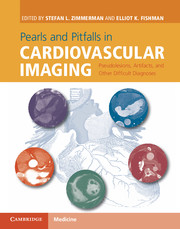 Pearls and Pitfalls in Cardiovascular Imaging
Pearls and Pitfalls in Cardiovascular Imaging Book contents
- Frontmatter
- Contents
- List of contributors
- Preface
- Section 1 Cardiac pseudotumors and other challenging diagnoses
- Section 2 Cardiac aneurysms and diverticula
- Section 3 Anatomic variants and congenital lesions
- Section 4 Coronary arteries
- Section 5 Pulmonary arteries
- Section 6 Cardiovascular MRI artifacts
- Section 7 Acute aorta and aortic aneurysms
- Section 8 Post-operative aorta
- Case 66 Surgical pledget mimicking aortic pseudoaneurysm
- Case 67 Pseudoendoleak post-endovascular stent graft placement due to calcified material in the aneurysm sac
- Case 68 Type II endoleak occult on arterial phase images
- Case 69 Elephant trunk graft mimicking aortic dissection
- Case 70 Pseudodissection due to aortic graft kinking
- Case 71 Perigraft fluid collections
- Case 72 Post-operative air in the aorta: when is it of concern?
- Section 9 Mesenteric vascular
- Section 10 Peripheral vascular
- Section 11 Veins
- Index
- References
Case 68 - Type II endoleak occult on arterial phase images
from Section 8 - Post-operative aorta
Published online by Cambridge University Press: 05 June 2015
- Frontmatter
- Contents
- List of contributors
- Preface
- Section 1 Cardiac pseudotumors and other challenging diagnoses
- Section 2 Cardiac aneurysms and diverticula
- Section 3 Anatomic variants and congenital lesions
- Section 4 Coronary arteries
- Section 5 Pulmonary arteries
- Section 6 Cardiovascular MRI artifacts
- Section 7 Acute aorta and aortic aneurysms
- Section 8 Post-operative aorta
- Case 66 Surgical pledget mimicking aortic pseudoaneurysm
- Case 67 Pseudoendoleak post-endovascular stent graft placement due to calcified material in the aneurysm sac
- Case 68 Type II endoleak occult on arterial phase images
- Case 69 Elephant trunk graft mimicking aortic dissection
- Case 70 Pseudodissection due to aortic graft kinking
- Case 71 Perigraft fluid collections
- Case 72 Post-operative air in the aorta: when is it of concern?
- Section 9 Mesenteric vascular
- Section 10 Peripheral vascular
- Section 11 Veins
- Index
- References
Summary
Imaging description
Following endovascular stent repair of abdominal aortic aneurysms, the most common complication is a type II endoleak. Endoleaks occur when blood continues to flow into the aneurysm sac after the procedure, carrying the risk of continued aneurysm expansion. On CT, endoleaks are identified by the presence of intravenous contrast within the aneurysm sac around the stent, which should normally be completely thrombosed. Five subtypes of endoleaks exist, but only types I–III will show contrast in the aneurysm sac at CT. These endoleaks are classified by the source of blood flow. In type II endoleaks, there is reperfusion of the aneurysm sac by aortic branch vessels. These are typically the inferior mesenteric artery or a lumbar artery branch, and are located anterior or posterior in the aneurysm sac depending on the feeding vessel.
Identification of a type II endoleak hinges on protocol optimization. The literature supports use of multiple acquisitions and narrow reconstruction sections to maximize likelihood of detecting an endoleak. With respect to the relative utility of different phases after contrast infusion, several studies have confirmed that use of delayed acquisition enables identification of more endoleaks than use of only an arterial phase acquisition. While many endoleaks are more conspicuous on the arterial phase, some will be more conspicuous or only visualized on the delayed phase (Figures 68.1and 68.2).
Importance
Studies show that more than half of type II endoleaks will resolve spontaneously, particularly those that do not result in enlargement of the aneurysm sac. However, the risk of a persistent endoleak is expansion of the aneurysm sac, which can result in rupture despite the presence of a stent. Arterial and delayed venous phase acquisitions are recommended for endovascular stent follow-up to avoid missing small type II endoleaks that may only be visible on the delayed phase.
Typical clinical scenario
Type II endoleaks occur in 19–24% of patients who undergo endovascular stent repair of an abdominal aortic aneurysm and account for 40% of endoleaks. These can be identified on the first follow up CT examination, or develop later.
Information
- Type
- Chapter
- Information
- Pearls and Pitfalls in Cardiovascular ImagingPseudolesions, Artifacts, and Other Difficult Diagnoses, pp. 218 - 220Publisher: Cambridge University PressPrint publication year: 2015